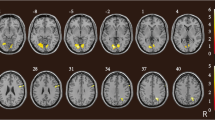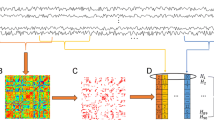Abstract
Aberrant local connectivity within cerebral intrinsic connectivity networks (ICNs) at rest has not been reported in adult moyamoya disease (MMD). Our aim was to examine the regional homogeneity (ReHo) of executive control (ECN), default mode (DMN), and salience networks (SN) in patients with executive dysfunction to explore the underlying mechanism. Twenty-six adult patients with MMD and 24 normal control (NC) subjects were recruited. Executive function was evaluated by Trail Making Test Part B (TMT-B) and executive subtests of Memory and Executive Screening (MES-EX). Compared with NC, the case group exhibited ReHo decrease mainly in the frontal and parietal gyrus, and increase only in the left middle temporal gyrus. Subsequent ICNs analysis indicated that compared with NC, patients with MMD exhibited significantly decreased ReHo in the dorsolateral prefrontal cortex (DLPFC) and inferior parietal gyrus (IPG) of left ECN; the IPG, superior frontal gyrus, and DLPFC of the right ECN; the right precuneus, left medial superior frontal gyrus, and right medial orbitofrontal gyrus of the DMN; as well as the left middle frontal gyrus and right supplemental motor area of SN. When referring to the Suzuki’s 6-stage classification, a trend of ReHo decrease with disease severity was observed in all of the ICNs examined, but only bilateral ECNs reached statistical significance. Finally, only bilateral ECNs exhibited a significant correlation of averaged ReHo values with executive performance. Our results provide new insight into the pathophysiology of adult MMD.





Similar content being viewed by others
References
Biswal, B., Yetkin, F. Z., Haughton, V. M., & Hyde, J. S. (1995). Functional connectivity in the motor cortex of resting human brain using echo-planar MRI. Magnetic Resonance in Medicine, 34(4), 537–541.
Bressler, S. L., & Menon, V. (2010). Large-scale brain networks in cognition: emerging methods and principles. Trends in Cognitive Sciences, 14(6), 277–290.
Buckner, R. L., Andrews-Hanna, J. R., & Schacter, D. L. (2008). The brain's default network: anatomy, function, and relevance to disease. Annals of the New York Academy of Sciences, 1124, 1–38.
Calviere, L., Catalaa, I., Marlats, F., Viguier, A., Bonneville, F., Cognard, C., et al. (2010). Correlation between cognitive impairment and cerebral hemodynamic disturbances on perfusion magnetic resonance imaging in European adults with moyamoya disease. Clinical article. Journal of Neurosurgery, 133(4), 753–759.
Cocchi, L., Halford, G. S., Zalesky, A., Harding, I. H., Ramm, B. J., Cutmore, T., et al. (2014). Complexity in relational processing predicts changes in functional brain network dynamics. Cerebral Cortex, 24(9), 2283–2296.
Cole, M. W., Reynolds, J. R., Power, J. D., Repovs, G., Anticevic, A., & Braver, T. S. (2013). Multi-task connectivity reveals flexible hubs for adaptive task control. Nature Neuroscience, 16(9), 1348–1355.
Festa, J. R., Schwarz, L. R., Pliskin, N., Cullum, C. M., Lacritz, L., Charbel, F. T., et al. (2010). Neurocognitive dysfunction in adult moyamoya disease. Journal of Neurology, 257(5), 806–815.
Gorelick, P. B., Scuteri, A., Black, S. E., Decarli, C., Greenberg, S. M., Iadecola, C., et al. (2011). Vascular contributions to cognitive impairment and dementia: a statement for healthcare professionals from the American heart association/American stroke association. Stroke, 42(9), 2672–2713.
Guo, Q. H., Zhou, B., Zhao, Q. H., Wang, B., & Hong, Z. (2012). Memory and executive screening (MES): a brief cognitive test for detecting mild cognitive impairment. BMC Neurology, 12, 119.
Karzmark, P., Zeifert, P. D., Tan, S., Dorfman, L. J., Bell-Stephens, T. E., & Steinberg, G. K. (2008). Effect of moyamoya disease on neuropsychological functioning in adults. Neurosurgery, 62(5), 1048–1051 discussion 1051-1052.
Karzmark, P., Zeifert, P. D., Bell-Stephens, T. E., Steinberg, G. K., & Dorfman, L. J. (2012). Neurocognitive impairment in adults with moyamoya disease without stroke. Neurosurgery, 70(3), 634–638.
Katzman, R., Zhang, M. Y., Ouang-Ya-Qu, W. Z. Y., Liu, W. T., Yu, E., et al. (1998). A Chinese version of the mini-mental state examination; impact of illiteracy in a Shanghai dementia survey. Journal of Clinical Epidemiology, 41(10), 971–978.
Kazumata, K., Tha, K. K., Narita, H., Kusumi, I., Shichinohe, H., Ito, M., et al. (2015). Chronic ischemia alters brain microstructural integriy and cognitive performance in adult moyamoya disease. Stroke, 46(2), 354–360.
Lei, Y., Li, Y. J., Ni, W., Jiang, H. Q., Yang, Z., Guo, Q. H., et al. (2014). Spontaneous brain activity in adult patients with moyamoya disease: a resting-state fMRI study. Brain Research, 1546, 27–33.
Liang, X., Zou, Q. H., He, Y., & Yang, Y. H. (2015). Topologically reorganized connectivity architecture of default-mode, executive-control, and salience networks across working memory task loads. Cerebral Cortex. doi:10.1093/cercor/bhu316.
Lu, L., & Bigler, E. D. (2002). Normative data on trail making test for neurologically normal, Chinese-speaking adults. Applied Neuropsychology, 9(4), 219–225.
Schubert, G. A., Czabanka, M., Seiz, M., Horn, P., Vajkoczy, P., & Thomé, C. (2014). Perfusion characteristics of moyamoya disease: an anatomically and clinically oriented analysis and comparison. Stroke, 45(1), 101–106.
Seeley, W. W., Menon, V., Schatzberg, A. F., Keller, J., Glover, G. H., Kenna, H., et al. (2007). Dissociable intrinsic connectivity networks for salience processing and executive control. The Journal of Neuroscience, 27(9), 2349–2356.
Shirer, W. R., Ryali, S., Rykhlevskaia, E., Menon, V., & Greicius, M. D. (2012). Decoding subject-driven cognitive states with whole-brain connectivity patterns. Cerebral Cortex, 22(1), 158–165.
Sridharan, D., Levitin, D. J., & Menon, V. (2008). A critical role for the right fronto-insular cortex in switching between central-executive and default-mode networks. Proceedings of the National Academy of Sciences of the United States of America, 105(34), 12569–12574.
Suzuki, J., & Takaku, A. (1969). Cerebrovascular “moyamoya” disease. Disease showing abnormal net-like vessels in base of brain. Archives of Neurology, 20(3), 288–299.
Vincent, J. L., Kahn, I., Snyder, A. Z., Raichle, M. E., & Bucker, R. L. (2008). Evidence for a frontoparietal control system revealed by intrinsic functional connectivity. Journal of Neurophysiology, 100(6), 3328–3342.
Weinberg, D. G., Rahme, R. J., Aoun, S. G., Batjer, H. H., & Bendok, B. R. (2011). Moyamoya disease: functional and neurocognitive outcomes in the pediatric and adult populations. Neurosurgical Focus, 30(6), E21.
Wu, T., Long, X. Y., Zang, Y. F., Wang, L., Hallett, M., Li, K. C., et al. (2009). Regional homogeneity changes in patients with Parkinson’s disease. Human Brain Mapping, 30(5), 1502–1510.
Xin, F., & Lei, X. (2015). Competition between frontoparietal control and default networks supports social working memory and empathy. Social Cognitive and Affective Neuroscience. doi:10.1093/scan/nsu160.
Zang, Y. F., Jiang, T. Z., Lu, Y. L., He, Y., & Tian, L. X. (2004). Regional homogeneity approach to fMRI data analysis. NeuroImage, 22(1), 394–400.
Acknowledgments
This work is supported by grant 2014CB541604 from the National Key Basic Research Program of China (973 Program) and grant 81371307 from the National Natural Science Foundation of China.
Author information
Authors and Affiliations
Corresponding author
Ethics declarations
All research procedures were approved by the Institutional Ethics Committee of Huashan Hospital of Fudan University, and were conducted in accordance with the 1964 Helsinki declaration and its later amendments. All participants gave written informed consent after totally understanding the purposes of our study.
Conflicts of interest
Yu Lei, Jiabin Su, Hanqiang Jiang, Qihao Guo, Wei Ni, Heng Yang, Yuxiang Gu, and Ying Mao declare that they have no conflicts of interest.
Additional information
Yu Lei and Jiabin Su contributed equally to this work.
Rights and permissions
About this article
Cite this article
Lei, Y., Su, J., Jiang, H. et al. Aberrant regional homogeneity of resting-state executive control, default mode, and salience networks in adult patients with moyamoya disease. Brain Imaging and Behavior 11, 176–184 (2017). https://doi.org/10.1007/s11682-016-9518-5
Published:
Issue Date:
DOI: https://doi.org/10.1007/s11682-016-9518-5




